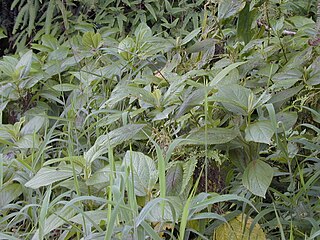
Prunus serrulata or Japanese cherry is a species of cherry tree that grows naturally in Japan, China, Korea, and Vietnam, and it also refers to a cultivar produced from Prunus speciosa, a cherry tree endemic in Japan. Historically, the Japanese have developed many cultivars by selective breeding of cherry trees, which are produced by the complicated crossing of several wild species, and they are used for ornamental purposes all over the world. Of these, the cultivars produced by complex interspecific hybrids based on the Oshima cherry are also known as the Cerasus Sato-zakura Group.

Boehmeria is a genus of 47 species of flowering plants in the nettle family Urticaceae. Of the species, 33 are indigenous to the Old World and 14 to the New World; no species is indigenous to both the Old and New Worlds. The species include herbaceous perennials, shrubs and small trees. Although related to the similar-looking species of the stinging nettles of genus Urtica, species of Boehmeria do not have stinging hairs. Because of the similarity in appearance, some species are commonly called "false nettles".

Astilbe is a genus of 18 species of rhizomatous flowering plants within the family Saxifragaceae, native to mountain ravines and woodlands in Asia and North America. Some species are known by the common names false goat's beard and false spirea.

Rhabdodendron is a genus of flowering plant in the family Rhabdodendraceae. It comprises three species of tropical South American trees.

Macromeles tschonoskii is a species of flowering plant in the family Rosaceae. It is a tree endemic to Japan.

Ochrosia is a genus of flowering plants, first described in 1789. It is in the family Apocynaceae, native to Southeast Asia, Australia, and various islands of the Indian and Pacific Oceans.

Myodocarpaceae is a family of flowering plants which contains 2 genera and 15 species. The family is accepted under the APG IV system and placed in the order Apiales. In earlier systems the two genera were included among the Araliaceae.

Lagenophora is a genus of flowering plants in the family Asteraceae. Species occur in South-east Asia, Australia, New Zealand, as well as Central and South America.

Hydrangea chinensis is a species of flowering plant in the family Hydrangeaceae, native to Myanmar, southeast China, and Taiwan. It grows in valleys and on mountain tops and slopes.
Rubus calycinoides is a flowering plant in the rose family (Rosaceae) native to Asia from the Himalayas to Myanmar. It was described by Otto Kunze in 1879.

Zabelia is a genus of flowering plants in the family Caprifoliaceae. It includes eight species native to temperate Asia, ranging from Central Asia through the Himalayas to China, Korea, and Japan.

Phryma is a genus of flowering plant in the family Phrymaceae, native to temperate Asia and eastern North America.

Tubocapsicum is a genus of flowering plants belonging to the family Solanaceae.
Taimingasa is a genus of flowering plants belonging to the family Asteraceae.
Cladopus is a genus of flowering plants belonging to the family Podostemaceae.
Hydrobryum is a genus of flowering plants belonging to the family Podostemaceae. It includes 33 species native to subtropical and tropical Asia, ranging from Nepal through the eastern Himalayas, Indo-China, and southern China to Japan.

Eleutherococcus sieboldianus, the five-fingered aralia or fiveleaf aralia, is a species of flowering plant in the family Araliaceae. It is native to Anhui province in China, and has been introduced to Korea, Japan and the United States. A variegated form is available which only reaches 8 ft (2.4 m).

Phryma nana is a species of flowering plant in the family Phrymaceae, native to Japan. It was first described by the Japanese botanist Gen-ichi Koidzumi in 1939. Its status as a separate species was not usually accepted, and it was treated as a subspecies or variety of Phryma leptostachya. In 2016, the distinctiveness of the Japanese P. nana was again supported, based on both earlier molecular phylogenetic analysis and morphological analysis. As of April 2022, the species is recognized by Plants of the World Online.

Phryma oblongifolia is a species of flowering plant in the family Phrymaceae, native from temperate Asia southwards to the Himalayas and north Vietnam. It was first described by Gen-ichi Koidzumi in 1929. Its status as a separate species was not usually accepted, and it was treated as a variety of Phryma leptostachya. In 2014, the distinctiveness of North American P. leptostachya and Asian P. oblongifolia was supported, based on morphological evidence and a previous molecular phylogenetic study. As of April 2022, the species is recognized by Plants of the World Online.

Macromeles is a genus of flowering plants in the rose family, Rosaceae. It includes two species native to Asia.
















